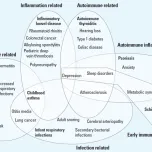From Health & Environment, a monthly website and e-publication about preventing harm to health from environmental contaminants. Subscribe here.
---
Rodney R Dietert, Professor of Immunotoxicology at Cornell University (USA), would like to make a very simple point: diseases are inter-related.
It might seem obvious that a patient manifesting one disease or condition is more likely, later on, to develop another, but Dietert says our medical and regulatory systems do not routinely recognise this – there simply is not a published literature on the subject.
As a result we are treating symptoms while failing to anticipate how a person’s health is likely to change in future, and we are underestimating the cost of environmental causes of illness.
In a paper published in this month’s Environmental Health Perspectives, Dietert argues for a new approach to both treating and preventing disease, based on mapping the relationships between different illnesses.
He argues that “illnesses such as type 1 diabetes and asthma are not only the end result of environmental exposures interacting with genetic background; they are the entryway into larger environmentally-associated health concerns”.
So far the only disease which is being interpreted in these terms is metabolic syndrome, where its relation to cardiovascular disease, diabetes and stroke is well-understood and incorporated into the rationale for both preventing and treating the illness.
As an immunologist, Dietert sees similar opportunities for understanding the origins and consequences of disorders relating to immune dysfunction. Here, Dietert identifies five entryway conditions caused by insults to the developing immune system (see illustration, where entryway conditions are shown in bold).
Childhood asthma is one of the most important because of its entryway status in relation to three disease patterns relating to the body’s response to inflammation, allergy and infection.
Because childhood asthma is not, on Dietert’s terms, an isolated illness but a pattern of health risks across a lifetime, it means the benefits of preventing asthma multiply up far beyond the cost medicine days off work. Preventing the immune insults which lead to entryway diseases is therefore far more valuable than currently calculated.
To better understand the costs and health effects of the environmental risk factors which cause inflammatory dysfunction, it is necessary to test the developmental immunotoxicity of chemicals to which the foetus and infant are exposed.
This is not, however, currently a regulatory requirement. Instead, chemicals are tested on adult animals, from which potential toxicity to the infant extrapolated – even though effects on a developing immune system are known to bear little comparison to effects on a developed, adult immune system.
“We aren’t even measuring for developmental effects of chemicals,” says Dietert. “If asthma on its own isn’t enough, perhaps the additional risks of asthma plus everything else that might happen to a person as they are ageing up to 65 years old, makes these assessments valuable enough [for regulators].”


Please log in or sign up to comment.